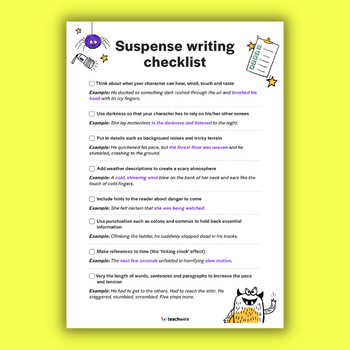Building suspense in writing KS2 – How to write stories with tension, atmosphere and suspense

These creative writing ideas and examples will help pupils use compelling language to keep the reader on the edge of their seat…

- by Teachwire
- Classroom expertise and free resources for teachers

One of the areas of creative fiction writing that KS2 pupils consistently fail to incorporate into their work is the technique of building suspense in writing.
The following simple steps from nasen education director Alison Wilcox will have an immediate impact on children’s story writing…
Building suspense in writing – KS2 advice
Use your senses
As well as sight, think about what your character can hear, smell, touch and taste.
This will enable the reader to feel the tension, the anticipation, the warning of approaching danger etc. more easily. For example:
Sounds
- The footsteps were louder. Another creak, another shuffle, just down the corridor. Now only seconds away.
- The sound of the wind among the trees suddenly stopped.
- The world was completely still. Nothing moved, not a leaf quivered, but over the silence brooded a ghostly calm and the whisper of his smoking breath as it rose in gasps and lingered in the frosty air.
Touch
- Her foot kicked something round, hollow, something which rolled away into the shadows.
- He ducked as something dark rushed through the air and brushed his head with its icy fingers.
Smell
- Trish cupped her fingers around her nose and mouth, but the stench of graveyards and decay wafting up from the darkness seeped through her fingers and made her retch.
- She took out a handful of green powder from her purse and tossed it on the fire. Within seconds, a very sweet and heady scent filled the room.
Taste
- The drink was bitter and stung her throat as she swallowed it. She could feel it scorching through her veins.
Suspense writing resources
Suspense writing checklist

Looking for teaching resources? Use this handy suspense writing checklist for KS2 which summarises the advice in this article.
Suspense writing example

This free building suspense in writing KS2 PDF from literacy expert Pie Corbett features an original tension writing example and classroom activities to help pupils with their own tension story ideas.
Senses template

Use this building suspense in writing KS2 senses template and exclusive scary extract from author Gabriel Dylan to help KS2 pupils develop their descriptive writing.
Building tension WAGOLL pack

Peer inside the mind of a professional author and help KS2 pupils understand how to build tension and write a nerve-wracking scene. This free WAGOLL resource pack is based on The Boy in the Suit by James Fox.
Scary adjectives word mat

Enhance your pupils’ descriptive writing skills with this scary adjectives PDF, perfect for helping children craft chilling and atmospheric settings that elevate their creative writing.
Use darkness to help the reader paint a picture
A good tip for building suspense in writing in KS2 is to focus on darkness. This means that the character(s) has to rely on his/her other senses and makes it easier to include sounds, touch and smells, which adds to the tension.
Add detail and description to paint a picture in the reader’s mind and create really spine-tingling stories.
Giving a setting an atmosphere is more than stating that ‘it was dark’. For example, adding more descriptive detail could give you:
She lay motionless in the darkness and listened to the night. It was an unsettling, menacing darkness, full of dancing shadows and the occasional creak and rustle from the house. A tingling sixth sense warned Kitty not to move.
Keep things building throughout your writing
By gradually adding to the atmosphere you are creating, you increase tension; making the setting scary and the action scenes exciting.
Think about putting in details such as background noises, flickering lights, dark shadows and tricky terrain such as muddy or uneven ground during a chase. For example:
- The batteries in her torch were running low and the beam kept flickering and fading as she moved it from side to side.
- Rob couldn’t tell where the steps were coming from. He quickened his pace, but the ground was uneven and he stumbled, crashing to the ground.
Use the weather to build suspense

Weather and darkness can be used to great effect to create a scary atmosphere and tension:
- Howling winds
- Mist or fog
- Ferocious storms
- Relentless rain
- Dusk, shadows
- Pitch black
For example:
Trending
- It was taking too long. The shadows spread and lengthened. She looked at her watch again.
- She should have heard something by now. All day she had been haunted by the feeling that she was being followed, and her fear grew as night fell. Fear of the unknown. Fear of what lurked in the shadows.
- A cold, shivering wind blew on the back of her neck and ears like the touch of cold fingers. Suddenly, the whole world seemed unnaturally dark, as if it had been drained of all light.
- The wind was ferocious, gaining in power all the time, until it screamed over the house and beat like a fist against the walls.
As before, adding detail and description will give the reader a more vivid sense of what is happening:
It was quiet. Too quiet! The birds had fallen silent and even the wind seemed to have died down. All was as still as death and dark as the grave.
Give readers a clue
Include hints to the reader of the danger to come or indications that the danger is getting closer. Think about:
- Entering the danger zone – what’s lurking outside, at the top of the stairs?
- A feeling of being followed/watched
- Fear of discovery in a hiding place as footsteps/voices, thuds, crashes get closer.
Consider how punctuation can enhance your suspense story
Include a sentence that holds back essential information from the reader until its ending, using colons, commas and repeated full stops to delay the revelation.
For example:
- Climbing the ladder, he suddenly stopped dead in his tracks.
- She heard the shuffle of footsteps, the scrape of metal. Silence. A shadow loomed over her. She dropped to her knees. Silhouetted in the flickering light was….
Refer to time

Build a sense of tension by making frequent references to time (the ‘ticking clock’ effect):
- Could he make it in time?
- He searched desperately for a way to escape. Frantic now… time was running out.
- The next few seconds unfolded in horrifying slow motion.
- For fatal seconds he stared, unable to think or move. And as he faltered, the jaws of the trap closed around him.
Vary your word, sentence and paragraph length
Vary the length of words, sentences and paragraphs to increase the pace and tension – this is a great way of building suspense in writing in KS2.
Use short words, for example, ‘at once’, rather than, ‘immediately’.
Place several short sentences consecutively: She ducked. He lunged.
Include one or two-word sentences. For example: ‘Oh no!’ or ‘Coming closer. Too close.’
Convey action with partial sentences
When the action is fast, use partial sentences:
He had to get to the others. Had to reach the attic. He staggered, stumbled, scrambled. Five steps more.
Use short paragraphs – some may be a single line.
Include lots of verbs to convey action and create a fast pace; use several verbs in a single sentence.
Alison Wilcox is education director at nasen. Browse more creative writing prompts.










